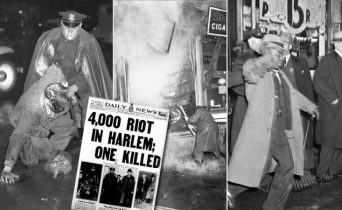
Although poverty, hunger, and the need for shelter affected New Yorkers all over the city, there was no place in the city of New York that struggled with these problems more than those who lived in Harlem, New York. Residents of Harlem found themselves not only having to deal with an unemployment rate of over 50%, but having to overcome discrimination against African Americans and immigrants in the work field.[1] Although discrimination against African Americans and immigrants had very much already been a part of the New York culture before the Depression, the depression amplified the factor astronomically. African Americans found themselves being banned from over 24 of the city’s trade unions.[2] African Americans as well as immigrants often found themselves being discriminated against by different shop workers as well as foreman and supervisors at public relief work sites, being denied the opportunity to work. Tensions from the discrimination grew so high that a riot broke out on March 19th, 1935 because of a misunderstanding surrounding the treatment of a 16-year-old Puerto Rican boy accused of stealing from a white shop.[3] The arresting officer was allegedly escorting the boy out the back door of the store to release him when a woman shouted that the officer was bringing the boy to the basement to beat him. The confusion caused the spreading of the rumor which amassed a mob of furious blacks and immigrants who began to vandalize the store along with other white owned shops on the street. By the end of the night, thousands of residents of Harlem had joined in the riot. With the conclusion of the riot, there was nearly 2 million dollars in damages done, thirty people had to be hospitalized, and three African Americans lost their lives.[4] The riots caused the mayor of New York to investigate the degree of discrimination that African Americans and immigrants were receiving during the Depression, but the results sickened him and he refused to let them be published.[5] Unfortunately, the riots were unable to bring justice for the Harlem community as its conditions did not change much until after the end of the depression.
[1] McDowell, W. (1984). Race and Ethnicity During the Harlem Jobs Campaign, 1932-1935. Journal of Negro History, 69(3/4), 134-146
[2] Ibid, 136
[3] Ibid, 142
[4] Ibid, 143
[5] Burs and Sanders, 437
Thanks for the research. I’m reading “Daddy Was a Number Runner” by L. Meriwether for the first time since I was 12. This time around I’m more interested in depression-era Harlem. This article gives historical background to the story.